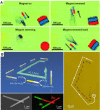One-dimensional micro/nanomotors for biomedicine: delivery, sensing and surgery
- PMID: 35837656
- PMCID: PMC9255815
- DOI: 10.3877/cma.j.issn.2096-112X.2020.01.003
One-dimensional micro/nanomotors for biomedicine: delivery, sensing and surgery
Abstract
The rapid development of artificial micro/nanomachines brings promising strategies to overcome challenges in biomedicine, including delivery, sensing and surgery. One-dimensional (1D) micro/nanomotors are one of the most attractive micro/nanomachines due to their high specific surface area, powerful impetus and weak rotation diffusion. In this review, different propulsion mechanisms and motion control strategies of 1D micro/nanomotors are summarized, and recent efforts towards their fabrication methods and biomedical applications are discussed. We envision the multidisciplinary research efforts in the field of 1D micro/nanomotors will pave their way to practical applications in bioimaging and biomedicine.
Keywords: biomedicine; micromotor; nanomotor; one-dimensional.
Figures











References
-
- Giulianotti P. C., Coratti A., Angelini M., Sbrana F., Cecconi S., Balestracci T., Caravaglios G. Robotics in general surgery: personal experience in a large community hospital. Arch Surg. 2003;138:777–784. - PubMed
-
- Nelson B. J., Kaliakatsos I. K., Abbott J. J. Microrobots for minimally invasive medicine. Annu Rev Biomed Eng. 2010;12:55–85. - PubMed
-
- Abdelmohsen L., Peng F., Tu Y., Wilson D. A. Micro- and nano-motors for biomedical applications. J Mater Chem B. 2014;2:2395–2408. - PubMed
-
- Peng F., Tu Y., Wilson D. A. Micro/nanomotors towards in vivo application: cell, tissue and biofluid. Chem Soc Rev. 2017;46:5289–5310. - PubMed
Publication types
LinkOut - more resources
Full Text Sources
